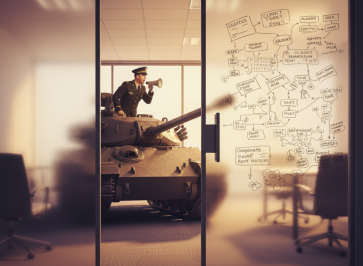Navy Seal Jocko Willink discovered that when he stopped shooting during a combat mission he could see the battle in its entirety, he was in a stronger position to manage the operation to success.
Similarly, I was reading Cameron Herold’s “The Second in Command“ and he said about COOs: “It’s not about doing stuff. It’s about getting stuff done”.
For a COO to be effective, they need to have enough bandwidth to get above it all and see the operation from above rather than getting sucked into the weeds.
If a COO needs to do this, imagine how hard it is for a CEO to have time to work on their strategy and vision if they do not yet have a COO?
Although Cameron defines 7 types of COO in his book, the one thing they all have in common are skills in people, leadership and systems.
The COO needs to grow and enable the team so they are accountable for running their area of the business, champion the culture and have the operation running smoothly.
My favourite lesson from “The Second in Command”, as nicely illustrated on the cover, is that the ideal COO for a CEO is like the Yin to the CEO’s Yang.
The ideal COO should have strengths where the CEO has weaknesses, this is unique for every CEO.
You aren’t just looking for a “good” COO. You are looking for a COO that perfectly suits your needs.
If you are looking to hire an operator, meditate on your own gaps.
Example, you as CEO may be weak at Strategy. That’s ok, find a COO who can do this for you.
Here were my key takeaways:
1. Role Clarity
The COO’s primary responsibility is to support the CEO by ensuring that the company’s operations run smoothly and efficiently.
2. Trust and Communication
A successful COO-CEO relationship is built on trust and open communication.
Being transparent, honest, and consistently clear in communication fosters a strong working relationship.
3. Complementary Skills
A great COO possesses skills that complement the CEO’s strengths and weaknesses.
This synergy creates a balanced leadership team that can tackle a wide range of challenges.
4. Execution of Vision
While the CEO sets the vision, the COO is responsible for executing it.
This means turning strategic plans into actionable steps and ensuring that the company’s goals are met through effective operations.
5. Culture and Values
Uphold the company’s culture and values.
Lead by example and ensure the team follows.
6. Problem-Solving
A COO must be an adept problem-solver, capable of addressing and resolving issues efficiently.
This allows the CEO to focus on strategic growth without getting bogged down by operational challenges.
7. Team Building
Building and nurturing a strong team is a core responsibility.
The COO must hire the right people, foster their development, and ensure that the team works cohesively towards common goals.
8. Communication
Keep communication clear and simple.
Make sure everyone understands the company’s direction and their role in it.
9. Adaptability
Be adaptable and ready to handle change.
The business world is always evolving, and the COO must keep up.
10. Support and Challenge
While it’s vital to support the CEO, a good COO also knows when to challenge them constructively.
This dynamic ensures that decisions are well-rounded and in the best interest of the company.
Talk soon,
Lloyd
PS – Do you need to find the operational Yin to your Yang? Let’s chat.







